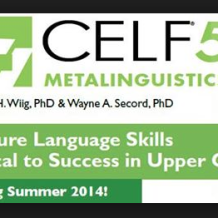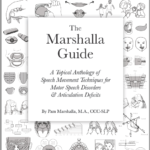First Impression CELF-5 Metalinguistics

I was a big fan of the Test of Language Competence (TLC). Almost every middle school student I tested received the TLC. It looked at areas of language not addressed by most basic language batteries. The only problem was, it was seriously outdated. Whenever I lost access to the test, I called Pearson to find out if an update was in the works. The answer was always no but I could never bring myself to purchase the TLC because it was so outdated. You can only imagine how thrilled I was to learn they were finally updating the TLC.
The Test of Language Competence has finally been replaced by The CELF-5 Metalinguistics. The CELF-5 Metalinguistics just arrived in the mail a few days ago so I won’t get a chance to administer it until the fall but I have had a chance to look it over thoroughly. My first impression is that I think I am going to like it. It is extremely similar to the TLC but with updated examples, pictures and other diagnostic material.
The major addition is a Metalinguistic Profile checklist. This is similar in style to the pragmatic profile on the CELF and is designed to be filled out by someone familiar with the student and the students culture. Finding that person might be a little tricky. I notice the language used in the Metalinguistic is rather professional and might be difficult for a parent or caregiver to understand. An SLP may have to walk the familiar person through the checklist. A standard score can be rom the checklist. Being a little old school myself, I’m not sure I like getting a scaled score from an observation. If we need to show data, we’re all set. However, the scaled score from the Metalinguistic Profile is not part of the composite scores.
- The Making Inferences subtest is exactly the same format as the Listening Comprehension: Making Inferences subtest on the TLC.
- The Conversation Skills subtest is very similar to the Oral Expression: Recreating Sentences subtest on the TLC. However, the context and prompts on the Conversation Skills subtest are more specific, meaning the student will have to be more specific on how they interpret the situation presented. I believe that’s a wonderful improvement that will provide significant diagnostic information.
- The Multiple Meaning subtest is exactly the same format as the Ambiguous Sentence subtest. This has always been one of my favorite subtests so I am glad they did not change it too much. Just noticed the new version still has the test item involving relatives visiting. Oh the things we SLP’s find funny.
- The Figurative Language subtest is the only subtest where the name hasn’t changed. I am a little concerned with the new examples but I’ll have to reserve judgement until I give the test a few hundred times. When I present figurative expressions to students, I always try to make sure several are within their realm of experience.
Just like the CELF 5 item analysis is provided at the end of each subtest. I don’t believe item analysis was available on the TLC. Item analysis might turn out to be very helpful or too much information. Personally I rarely used or reported the composite score from the TLC. I felt that the subtests were very different in the skills each addressed on the TLC. I was very selective about which TLC subtests I gave to students and always based my decision on their specific needs, abilities and cognitive skills. The CELF 5 metalinguistic, just like the TLC is not for everyone. (I often use the Test of Auditory Processing Cohesion Index or the Test of Problem Solving to obtain some similar information),
My first impression is that I am going to enjoy giving this test. I feel I will be able to obtain the diagnostic information that I will need to write appropriate educational plans and find entry points into therapy. My only disappointment is that the test does not go lower than 9. The TLC had separate but similar test items that went down to 5. I didn’t use the TLC that often for the students under 9 but when appropriate it was a excellent diagnostic tool.
If you are using the CELF-5, the CELF-5 Metalinguistics is a must have, especially when working with older children. It gives many test items in each section and is fairly quick to give.
I would love to hear about your first impressions, especially if you’ve had a chance to give the CELF-5 Metalinguistics.








I agree!! I really liked the TLC-expanded and used it for middle schoolers as well until the norms became obsolete. I have budgeted for the CELF-5 Metalinguistic and am eager to give it a drive!